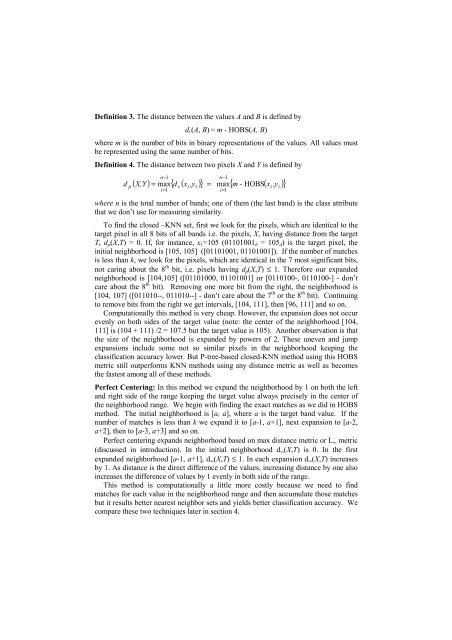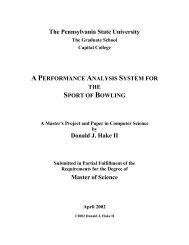k-Nearest Neighbor Classification on Spatial Data Streams Using P ...
k-Nearest Neighbor Classification on Spatial Data Streams Using P ...
k-Nearest Neighbor Classification on Spatial Data Streams Using P ...
You also want an ePaper? Increase the reach of your titles
YUMPU automatically turns print PDFs into web optimized ePapers that Google loves.
Definiti<strong>on</strong> 3. The distance between the values A and B is defined by<br />
d v (A, B) = m - HOBS(A, B)<br />
where m is the number of bits in binary representati<strong>on</strong>s of the values. All values must<br />
be represented using the same number of bits.<br />
Definiti<strong>on</strong> 4. The distance between two pixels X and Y is defined by<br />
d<br />
p<br />
n−1<br />
n−1<br />
( X,Y ) = max{ d ( x ,y )} = max{ m - HOBS( x ,y )}<br />
i=<br />
1<br />
v<br />
i<br />
i<br />
i=<br />
1<br />
where n is the total number of bands; <strong>on</strong>e of them (the last band) is the class attribute<br />
that we d<strong>on</strong>’t use for measuring similarity.<br />
To find the closed –KNN set, first we look for the pixels, which are identical to the<br />
target pixel in all 8 bits of all bands i.e. the pixels, X, having distance from the target<br />
T, d p (X,T) = 0. If, for instance, x 1 =105 (01101001 b = 105 d ) is the target pixel, the<br />
initial neighborhood is [105, 105] ([01101001, 01101001]). If the number of matches<br />
is less than k, we look for the pixels, which are identical in the 7 most significant bits,<br />
not caring about the 8 th bit, i.e. pixels having d p (X,T) ≤ 1. Therefore our expanded<br />
neighborhood is [104,105] ([01101000, 01101001] or [0110100-, 0110100-] - d<strong>on</strong>’t<br />
care about the 8 th bit). Removing <strong>on</strong>e more bit from the right, the neighborhood is<br />
[104, 107] ([011010--, 011010--] - d<strong>on</strong>’t care about the 7 th or the 8 th bit). C<strong>on</strong>tinuing<br />
to remove bits from the right we get intervals, [104, 111], then [96, 111] and so <strong>on</strong>.<br />
Computati<strong>on</strong>ally this method is very cheap. However, the expansi<strong>on</strong> does not occur<br />
evenly <strong>on</strong> both sides of the target value (note: the center of the neighborhood [104,<br />
111] is (104 + 111) /2 = 107.5 but the target value is 105). Another observati<strong>on</strong> is that<br />
the size of the neighborhood is expanded by powers of 2. These uneven and jump<br />
expansi<strong>on</strong>s include some not so similar pixels in the neighborhood keeping the<br />
classificati<strong>on</strong> accuracy lower. But P-tree-based closed-KNN method using this HOBS<br />
metric still outperforms KNN methods using any distance metric as well as becomes<br />
the fastest am<strong>on</strong>g all of these methods.<br />
Perfect Centering: In this method we expand the neighborhood by 1 <strong>on</strong> both the left<br />
and right side of the range keeping the target value always precisely in the center of<br />
the neighborhood range. We begin with finding the exact matches as we did in HOBS<br />
method. The initial neighborhood is [a, a], where a is the target band value. If the<br />
number of matches is less than k we expand it to [a-1, a+1], next expansi<strong>on</strong> to [a-2,<br />
a+2], then to [a-3, a+3] and so <strong>on</strong>.<br />
Perfect centering expands neighborhood based <strong>on</strong> max distance metric or L ∞ metric<br />
(discussed in introducti<strong>on</strong>). In the initial neighborhood d ∞ (X,T) is 0. In the first<br />
expanded neighborhood [a-1, a+1], d ∞ (X,T) ≤ 1. In each expansi<strong>on</strong> d ∞ (X,T) increases<br />
by 1. As distance is the direct difference of the values, increasing distance by <strong>on</strong>e also<br />
increases the difference of values by 1 evenly in both side of the range.<br />
This method is computati<strong>on</strong>ally a little more costly because we need to find<br />
matches for each value in the neighborhood range and then accumulate those matches<br />
but it results better nearest neighbor sets and yields better classificati<strong>on</strong> accuracy. We<br />
compare these two techniques later in secti<strong>on</strong> 4.<br />
i<br />
i
















